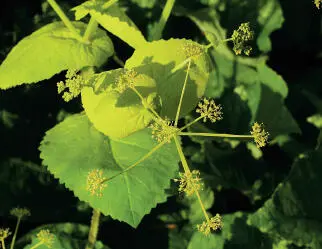
An interesting member of the foxglove family which can only germinate in the presence of host plants – grasses – from which it derives much of its sustenance during the early part of its life. The narrow, toothed leaves, bright yellow, lipped flowers and semi-translucent, pale green calyces make this a distinctive grassland species.
Soil preference:Moist, grass sward
Aspect:Sun
Season of interest:Summer
Height and spread:30cm × 15cm (1ft × 15cm)
Companion plants:The ‘impoverishing’ effect Rhinanthus has on grass growth is of great benefit because it enables other broad-leaved flowering plants to colonize more easily. Wonderful with Cardamine pratensis , cowslips, cranesbill and knapweeds.
Blue Centaurea cyanus produces an attractive picture when combined with red poppies, corn chamomile and corn marigold.
Planting Naturalistic Schemes
Many annuals which occur in the wild are opportunist plants which grow wherever the ground is disturbed. As fieldcrop weeds, many of them occur worldwide and among the most beautiful are those which colonize the ground among growing cereal crops. This cornfield scene, with its red poppies, blue cornflowers, yellow corn marigold and daisy-like corn chamomile would be simple to reproduce as part of a naturalistic planting scheme in an informal garden. Some wild annuals, however, may be too invasive to risk introducing into a garden – especially a small one.
To avoid creating problems with over-exuberant self-seeding, beds of annuals or ‘arable patches’ imitating cornfields should be contained. Solid pathways around their edges or other non-cultivable ground surfaces can help to prevent seed spread but may compromise the natural appearance. Annuals that are allowed to spill over their boundaries by self-seeding can be far more beautiful than those regimented in strict beds.
Biennials for spring
Biennials for summer
Biennials for special effects
Biennials beneficial to wildlife
Biennials for spring
Myosotis sylvatica
Forget-me-not Hardy biennial
Narrow, bright green leaves that form neat clumps over winter are joined from early spring by expanding spikes of tiny, pale centred, blue flowers. The first flowers nestle among the leaves, but as spring advances, the stems extend, creating a soft blue haze. A ready self-seeder. ‘Blue Ball’ is the most widely grown variety, but other seed series include ‘Victoria’ which has blue, white or pink flowers.
Soil preference:Any well-drained
Aspect:Sun or part shade
Season of interest:Spring, early summer
Height and spread:Up to 30cm × 40cm (1ft × 1ft 4in)
Companion plants:One of the finest companions for tulips, since it creates a soft, blue base. Charming when dotted among spring perennials such as Lathyrus vernus , yellow doronicums or polyanthus.
Erysimum cheiri
Bedding Wallflowers Hardy biennial
Shrubby biennial or shortlived perennial with narrow, evergreen leaves and from mid-spring spikes with bold-coloured, four-petalled flowers, which are sweetly fragrant. Dwarf bedding varieties include the mixed ‘Persian Carpet’. ‘Fire King’ is a taller orange red variety and ‘Blood Red’ an old breed with deep blood red flowers.
Soil preference:Any, preferably alkaline
Aspect:Sun
Season of interest:Spring
Height and spread:Up to 60cm × 40cm (2ft × 1ft 4in)
Companion plants:Pretty when bedded with tulips, but also handy for gap filling in a mixed or herbaceous border. Wallflowers work well with emerging lupin foliage, with tulips or with the hazy blue flowers of Brunnera macrophylla .
Erysimum
Perennial Wallflowers shortlived perennials, can be grown as biennials
Shrubby wallflower varieties with narrow, sometimes blue-grey leaves and a steady succession of stiff flower spikes held well clear of the leaves, and bearing four-petalled blooms in mauve, bronze, cream, yellow or red. Erysimum ‘Bowles Mauve’ is the best known but ‘Sunlight’ has yellow flowers and ‘Harpur Crewe’ small, double yellow, richly fragrant blooms.
Soil preference:Free-draining
Aspect:Sun
Season of interest:Spring, summer
Height and spread:Variable to 75cm × 60cm (2ft 6in × 2ft)
Companion plants:Good in a dry gravel or Mediterranean garden, with yellow-flowered Genista lydia and silver-leaved shrubs and herbs.
Digitalis purpurea
Foxglove Hardy biennial
Large, downy basal leaves in the first year are followed by tall, slender spikes furnished with many tubular downward-hanging flowers. The typical species has purplish pink flowers whose throats are thickly spotted with rusty marks, but garden forms come in a range of colours from white, through pale pink and apricot to deep purple.
Soil preference:Well-drained, but not too dry
Aspect:Shade or part shade
Season of interest:Late spring, early summer
Height and spread:Up to 2m × 60cm (6ft 6in × 2ft)
Companion plants:Excellent for woodland planting or to fill spaces between shrubs. Foxgloves are also lovely in cottage-style gardens, alongside cranesbills, old fashioned roses or with columbines.
Smyrnium perfoliatum
Biennial

A biennial with branched, winged stems and from mid-spring, showy, bract-like leaves which surround the flower umbels and are a vivid golden green. Lovely with the light coming through them, but this is an invasive plant which seeds a little too freely.
Soil preference:Any, not too damp
Aspect:Sun or shade
Season of interest:Spring
Height and spread.1m × 45cm (3ft 3in × 1ft 6in)
Companion plants:Good for filling up spaces below trees, or allowing to spread with such other umbelliferous plants as sweet cicely or cow parsley. Also handsome when planted with red tulips, or with purple honesty Lunaria annua .
Hesperis matronalis
Dames Violet, Sweet Rocket Biennial or shortlived perennial

Cabbage family member with narrow leaves held on stout flower spikes that are topped with generous clusters of four-petalled fragrant blooms, the perfume being especially strong at twilight. Colours range from white, through pale mauve to soft purple. Replace flowered plants with self-sown seedlings.
Soil preference:Any, moist
Aspect:Sun or part shade
Season of interest:Spring, early summer
Height and spread:1m × 30cm (3ft × 1ft)
Companion plants:A lovely species whose pale colours which show up well in poor light, and which go well with such bolder-hued early perennials as lupins, campanulas or even oriental poppies.
Читать дальше















